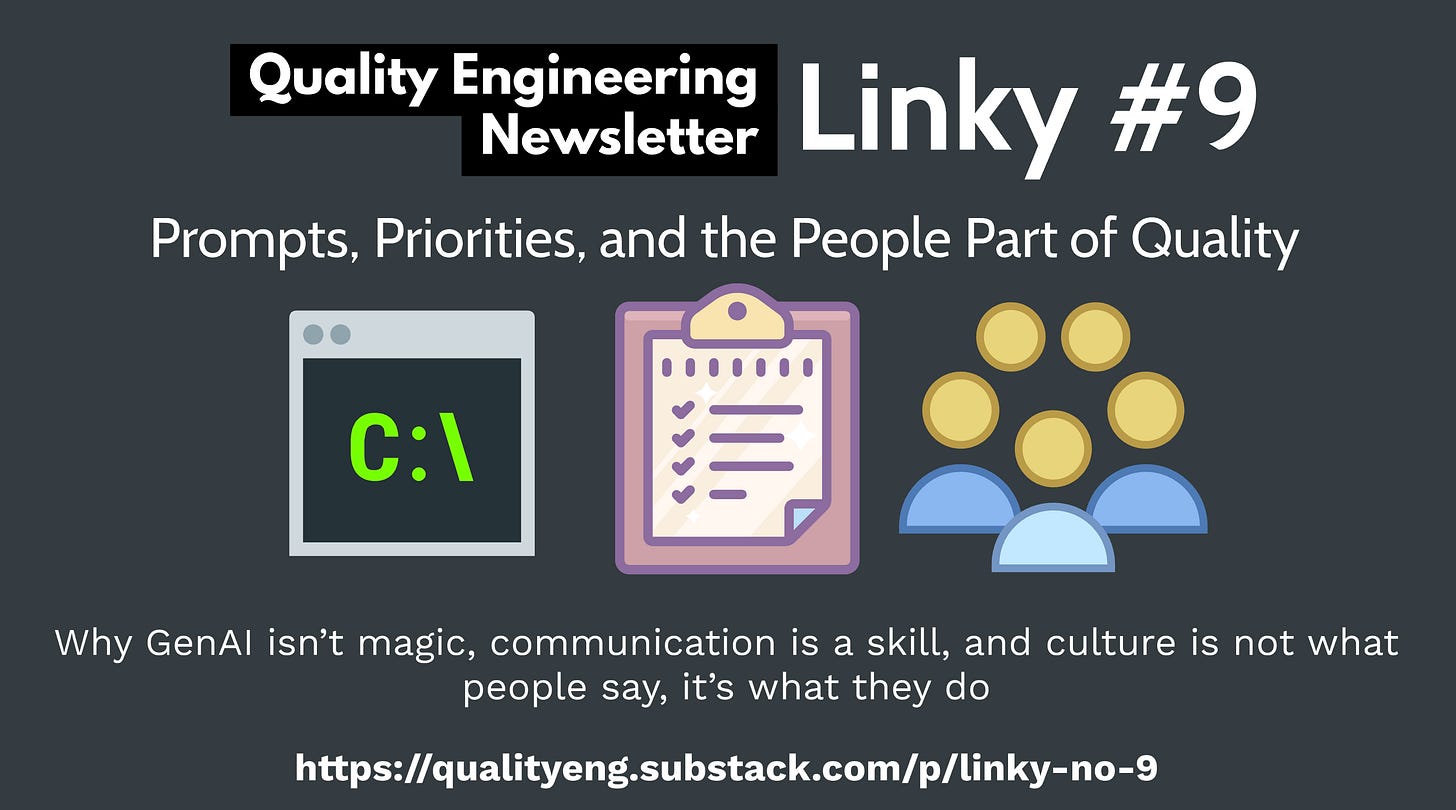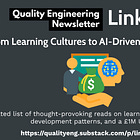Linky #9 - Prompts, Priorities, and the People Part of Quality
Why GenAI isn’t magic, communication is a skill, and culture is not what people say, it’s what they do
Welcome to Linky No. 9 (Scroll to the bottom for past issues.) In each edition, I share articles, essays, or books I've recently enjoyed, plus some thoughts on why they stood out and why I think they're worth your time.
This week’s edition explores collaboration with AI, the role of automated testing, how we think about quality, and some great tips on spotting real company culture in action.
Latest post from the Quality Engineering Newsletter
This year’s StarEast (like many conferences lately) was full of AI talk. My biggest takeaway? You still can’t outsource judgment. AI can assist, but it’s not replacing human insight anytime soon.
That means communication skills are about to become even more important. If we want AI to help us, we need to be able to clearly explain our goals, context, and constraints. Quality engineers are well placed here as we often have the broadest perspective on how quality is created, maintained, and lost in a system. That context matters more than ever.
From the archive
This is a post in which I explain why software development is inherently complex and why treating it that way matters for quality. Once we accept the complexity, the job becomes about making it healthier by nudging and boosting the behaviours that lead to better outcomes.
Google’s Prompt Engineering Guide
Strategies for writing better prompts
1. Set Clear Goals and Objectives
2. Provide Context and Background
3. Use Few-Shot Prompting
4. Be Specific
5. Iterate and Experiment
6. Use Chain of Thought Prompting
This guide from Google is a solid starting point for anyone experimenting with prompts. It’s accessible, practical, and full of examples. If you’re using AI to generate test cases, improve docs, or explore product ideas, this is worth a skim: Prompt Engineering for AI Guide | Google Cloud
Boosting quality in socio-technical systems
“Boosts are interventions designed to improve people’s competences to make informed choices that align with their goals…”
Boosts build people’s abilities to make changes, whether that’s through better digital literacy, stronger decision-making, or more effective risk understanding. I've written before about nudges and boosts in quality engineering. Developing this skill set is increasingly important for quality engineers. The paper mentioned in this LinkedIn post by Marc Harris is a great primer.
Culture is what people do, not what they say
There is some excellent advice here from Arpad, an executive recruiter on LinkedIn. He shares key questions to ask in interviews and what to look for in how your interviewer reacts.
Don’t just listen to answers. Watch how people react to the questions.
And if these questions make your interviewer uncomfortable?You’ve learned a lot right there.
Your interview experience is culture in action.
Were they transparent?
Did they show respect for your time and energy?
Did they challenge you — and welcome being challenged?Culture is not what they say. It’s what they do
This got me thinking about how you make sense of the culture you’re operating in. If culture is behaviour in action, then as QEs, we need to be master observers to understand that culture and find ways to nudge it towards something that supports the quality outcomes we want.
The full list of questions from Arpad’s post on LinkedIn is well worth a read. My favourite: "What’s one thing you’d change about the culture if you had a magic wand?"
Choosing your own hours
While the post is making fun of flexible working, it did get me thinking. I’m all for flexible hours, but let’s not forget that building software is a deeply collaborative process. More overlap with your team usually makes things smoother.
You probably spend as much time with your colleagues as you do with family. The more connected you feel to them, the better the work experience. Plus, they might actually understand what you do 😂 From Flexible Working Hours - Work Chronicles
How do you prioritise quality with everything else going on? You don’t.
Real product prioritization doesn’t rank features across completely different purposes. It sets intentional allocations.
This post hits the nail on the head. You don’t "make time" for quality later. You bake it in every sprint, every day. For example:
40% to growth
40% to quality
10% to UX
10% to tech debt
Trying to do it in cycles just leads to falling behind. Quality needs to be a constant.
Via Brian Peterson on LinkedIn
Most teams aren't ready for GenAI because they don’t have enough automated testing
"...effective GenAI-assisted development relies on having comprehensive automated tests and the ability to release frequently in small batches."
If you're using GenAI to speed you up, then the more you need to have invested in knowing how to build quality in through fast feedback loops. Otherwise, you'll only go as fast as your slowest process - usually manual testing. Now what we need to remember is you can't just swap out manual testing for automated. You need to build in layers of testing throughout your system of work. You eliminate the testing constraint by spreading it throughout the system, which requires a whole mindset shift in how we think about building software. GenAI coding: most teams aren't ready | Rob Bowley | LinkedIn
Treat AI like a teammate, not a tool 🤩
“The best users coach AI, give it feedback, and ask it to ask them questions too.”
This might be the best advice I’ve heard on using LLMs. Since adopting this mindset, I’ve gone from barking commands to having real back-and-forths. It’s like working through a problem with a teammate. Try this next time: "What do you need from me to to help me do X?" Simple shift. Big difference. From: How Stanford teaches AI
Let me know which links resonated or if you’ve read anything lately that should make the next Linky. Always up for a good share.













